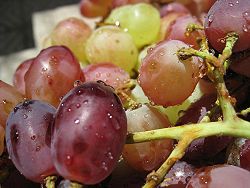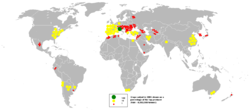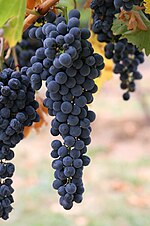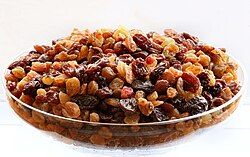| Nutritional value per 100 g (3.5 oz) | |
|---|---|
| Energy | 288 kJ (69 kcal) |
| Carbohydrates | 18.1 g |
| Sugars | 15.48 g |
| Dietary fiber | 0.9 g |
| Fat | 0.16 g |
| Protein | 0.72 g |
| Thiamine (Vit. B1) | 0.069 mg (5%) |
| Riboflavin (Vit. B2) | 0.07 mg (5%) |
| Niacin (Vit. B3) | 0.188 mg (1%) |
| Pantothenic acid (B5) | 0.05 mg (1%) |
| Vitamin B6 | 0.086 mg (7%) |
| Folate (Vit. B9) | 2 μg (1%) |
| Vitamin B12 | 0 μg (0%) |
| Vitamin C | 10.8 mg (18%) |
| Vitamin K | 22 μg (21%) |
| Calcium | 10 mg (1%) |
| Iron | 0.36 mg (3%) |
| Magnesium | 7 mg (2%) |
| Manganese | 0.071 mg (4%) |
| Phosphorus | 20 mg (3%) |
| Potassium | 191 mg (4%) |
| Sodium | 3.02 mg (0%) |
| Zinc | 0.07 mg (1%) |
| Percentages are relative to US recommendations for adults. Source: USDA Nutrient database | |
Contents[hide] |
History
The domestication of purple grapes originated in what is now southern Turkey. Yeast, one of the earliest domesticated microorganisms, occurs naturally on the skins of grapes, leading to the innovation of alcoholic drinks such as wine. Ancient Egyptian hieroglyphics record the cultivation of purple grapes, and history attests to the ancient Greeks, Phoenicians and Romans growing purple grapes for both eating and wine production. Later, the growing of grapes spread to Europe, North Africa, and eventually North America.Native purple grapes belonging to the Vitis genus proliferated in the wild across North America, and were a part of the diet of many North American Native Americans, but were considered by European colonists to be unsuitable for wine. The first Old World Vitis vinifera purple grapes were cultivated in California, where Spain had established a series of monasteries along the coasts to supply their navies with oranges to prevent scurvy and convert natives. There are old Greek troughs and coffins in the Getty Villa, and they show cherubs in tubs of grapes, making wine.
Description
Grapes grow in clusters of 15 to 300, and can be crimson, black, dark blue, yellow, green, orange, and pink. "White" grapes are actually green in color, and are evolutionarily derived from the purple grape. Mutations in two regulatory genes of white grapes turn off production of anthocyanins which are responsible for the color of purple grapes.[1] Anthocyanins and other pigment chemicals of the larger family of polyphenols in purple grapes are responsible for the varying shades of purple in red wines.[2][3]Grapevines
Main article: Vitis
Most grapes come from cultivars of Vitis vinifera, the European grapevine native to the Mediterranean and Central Asia. Minor amounts of fruit and wine come from American and Asian species such as:- Vitis labrusca, the North American table and grape juice grapevines (including the concord cultivar), sometimes used for wine, are native to the Eastern United States and Canada.
- Vitis riparia, a wild vine of North America, is sometimes used for winemaking and for jam. It is native to the entire Eastern U.S. and north to Quebec.
- Vitis rotundifolia, the muscadines, used for jams and wine, are native to the Southeastern United States from Delaware to the Gulf of Mexico.
- Vitis amurensis is the most important Asian species.
Distribution and production
According to the Food and Agriculture Organization (FAO), 75,866 square kilometres of the world are dedicated to grapes. Approximately 71% of world grape production is used for wine, 27% as fresh fruit, and 2% as dried fruit. A portion of grape production goes to producing grape juice to be reconstituted for fruits canned "with no added sugar" and "100% natural". The area dedicated to vineyards is increasing by about 2% per year.The following table of top wine-producers shows the corresponding areas dedicated to grapes for wine making:
| Country | Area dedicated |
|---|---|
| Spain | 11,750 km2 |
| France | 8,640 km2 |
| Italy | 8,270 km2 |
| Turkey | 8,120 km2 |
| United States | 4,150 km2 |
| Iran | 2,860 km2 |
| Romania | 2,480 km2 |
| Portugal | 2,160 km2 |
| Argentina | 2,080 km2 |
| Australia | 1,642 km2 |
| Armenia | 1,459 km2 |
| Lebanon | 1,122 km2 |
| Top Ten Grapes Producers – 8 October 2009 | ||||
|---|---|---|---|---|
| Country | Production (Tonnes) | Footnote | ||
| 8,519,418 | F | |||
| 6,787,081 | F | |||
| 6,384,090 | F | |||
| 6,044,900 | F | |||
| 5,995,300 | F | |||
| 3,612,781 | F | |||
| 3,000,000 | F | |||
| 2,900,000 | F | |||
| 2,350,000 | F | |||
| 1,667,700 | F | |||
| World | 67,221,000 | A | ||
| No symbol = official figure, P = official figure, F = FAOSTAT 2007, * = Unofficial/Semi-official/mirror data, C = Calculated figure A = Aggregate (may include official, semi-official or estimates); Source: Food And Agricultural Organization of United Nations: Economic And Social Department: The Statistical Division | ||||
There are no reliable statistics that break down grape production by variety. It is, however, believed that the most widely planted variety is Sultana, also known as Thompson Seedless, with at least 3,600 km2. (880,000 acres) dedicated to it. The second most common variety is Airén. Other popular varieties include Cabernet Sauvignon, Sauvignon blanc, Cabernet Franc, Merlot, Grenache, Tempranillo, Riesling and Chardonnay.[4]
Table and wine grapes
Commercially cultivated grapes can usually be classified as either table or wine grapes, based on their intended method of consumption: eaten raw (table grapes) or used to make wine (wine grapes). While almost all of them belong to the same species, Vitis vinifera, table and wine grapes have significant differences, brought about through selective breeding. Table grape cultivars tend to have large, seedless fruit (see below) with relatively thin skin. Wine grapes are smaller, usually seeded, and have relatively thick skins (a desirable characteristic in winemaking, since much of the aroma in wine comes from the skin). Wine grapes also tend to be very sweet: they are harvested at the time when their juice is approximately 24% sugar by weight. By comparison, commercially produced "100% grape juice", made from table grapes is usually around 15% sugar by weight. [5]Seedless grapes
Although grape seeds contain many nutrients, some consumers choose seedless grapes; seedless cultivars now make up the overwhelming majority of table grape plantings. Because grapevines are vegetatively propagated by cuttings, the lack of seeds does not present a problem for reproduction. It is, however, an issue for breeders, who must either use a seeded variety as the female parent or rescue embryos early in development using tissue culture techniques.There are several sources of the seedlessness trait, and essentially all commercial cultivators get it from one of three sources: Thompson Seedless, Russian Seedless, and Black Monukka, all being cultivars of Vitis vinifera. There are currently more than a dozen varieties of seedless grapes. Several, such as Einset Seedless, Reliance and Venus, have been specifically cultivated for hardiness and quality in the relatively cold climates of north-eastern United States and southern Ontario.[6]
An offset to the improved eating quality of seedlessness is the loss of potential health benefits provided by the enriched phytochemical content of grape seeds (see Health claims, below).[7][8]
Raisins, currants and sultanas
In most of Europe, dried grapes are referred to as "raisins" or the local equivalent. In the UK, three different varieties are recognized, forcing the EU to use the term "Dried vine fruit" in official documents.A raisin is any dried grape. While raisin is a French loanword, the word in French refers to the fresh fruit; grappe (from which the English grape is derived) refers to the bunch (as in une grappe de raisins).
A currant is a dried Zante Black Corinth grape, the name being a corruption of the French raisin de Corinthe (Corinth grape). Currant has also come to refer to the blackcurrant and redcurrant, two berries unrelated to grapes.
A sultana was originally a raisin made from a specific type of grape of Turkish origin, but the word is now applied to raisins made from common grapes and chemically treated to resemble the traditional sultana.
Health claims
French Paradox
Comparing diets among Western countries, researchers have discovered that although the French tend to eat higher levels of animal fat, surprisingly the incidence of heart disease remains low in France. This phenomenon has been termed the French Paradox, and is thought to occur from protective benefits of regularly consuming red wine. Apart from potential benefits of alcohol itself, including reduced platelet aggregation and vasodilation,[9] polyphenols (e.g., resveratrol) mainly in the grape skin provide other suspected health benefits, such as:[10]- Alteration of molecular mechanisms in blood vessels, reducing susceptibility to vascular damage
- Decreased activity of angiotensin, a systemic hormone causing blood vessel constriction that would elevate blood pressure
- Increased production of the vasodilator hormone, nitric oxide (endothelium-derived relaxing factor)
Resveratrol
Grape phytochemicals such as resveratrol (a polyphenol antioxidant), have been positively linked to inhibiting any cancer, heart disease, degenerative nerve disease, viral infections and mechanisms of Alzheimer's disease.[17][18]Protection of the genome through antioxidant actions may be a general function of resveratrol.[19] In laboratory studies, resveratrol bears a significant transcriptional overlap with the beneficial effects of calorie restriction in heart, skeletal muscle and brain. Both dietary interventions inhibit gene expression associated with heart and skeletal muscle aging, and prevent age-related heart failure.[20]
Resveratrol is the subject of several human clinical trials,[21] among which the most advanced is a one year dietary regimen in a Phase III study of elderly patients with Alzheimer's disease.[22]
Synthesized by many plants, resveratrol apparently serves antifungal and other defensive properties. Dietary resveratrol has been shown to modulate the metabolism of lipids and to inhibit oxidation of low-density lipoproteins and aggregation of platelets.[23]
Resveratrol is found in wide amounts among grape varieties, primarily in their skins and seeds which, in muscadine grapes, have about one hundred times higher concentration than pulp.[24] Fresh grape skin contains about 50 to 100 micrograms of resveratrol per gram.[25]
Anthocyanins and other phenolics
Anthocyanins tend to be the main polyphenolics in purple grapes whereas flavan-3-ols (e.g., catechins) are the more abundant phenolic in white varieties.[26] Total phenolic content, an index of dietary antioxidant strength, is higher in purple varieties due almost entirely to anthocyanin density in purple grape skin compared to absence of anthocyanins in white grape skin.[26] It is these anthocyanins that are attracting the efforts of scientists to define their properties for human health.[27] Phenolic content of grape skin varies with cultivar, soil composition, climate, geographic origin, and cultivation practices or exposure to diseases, such as fungal infections.Red wine offers health benefits more so than white because many beneficial compounds are present in grape skin, and only red wine is fermented with skins. The amount of fermentation time a wine spends in contact with grape skins is an important determinant of its resveratrol content.[5] Ordinary non-muscadine red wine contains between 0.2 and 5.8 mg/L,[28] depending on the grape variety, because it is fermented with the skins, allowing the wine to absorb the resveratrol. By contrast, a white wine contains lower phenolic contents because it is fermented after removal of skins.
Wines produced from muscadine grapes may contain more than 40 mg/L, an exceptional phenolic content.[24][29] In muscadine skins, ellagic acid, myricetin, quercetin, kaempferol, and trans-resveratrol are major phenolics.[30] Contrary to previous results, ellagic acid and not resveratrol is the major phenolic in muscadine grapes.
The flavonols syringetin, syringetin 3-O-galactoside, laricitrin and laricitrin 3-O-galactoside are also found in purple grape but absent in white grape.[31]
Seed constituents
Main articles: Grape seed extract and Grape seed oil
Since the 1980s, biochemical and medical studies have demonstrated significant antioxidant properties of grape seed oligomeric proanthocyanidins.[32] Together with tannins, polyphenols and polyunsaturated fatty acids, these seed constituents display inhibitory activities against several experimental disease models, including cancer, heart failure and other disorders of oxidative stress.[33][34]Grape seed oil from crushed seeds is used in cosmeceuticals and skincare products for many perceived health benefits. Grape seed oil is notable for its high contents of tocopherols (vitamin E), phytosterols, and polyunsaturated fatty acids such as linoleic acid, oleic acid and alpha-linolenic acid.[35][36][37]
Concord grape juice
Commercial juice products from Concord grapes have been applied in medical research studies, showing potential benefits against the onset stage of cancer,[38] platelet aggregation and other risk factors of atherosclerosis,[39] loss of physical performance and mental acuity during aging[40] and hypertension in humans.[41]Religious significance
See also: Wine#Religious_uses
In the Bible, grapes are first mentioned when Noah grows them on his farm (Genesis 9:20-21). Instructions concerning wine are given in the book of Proverbs and in the book of Isaiah, such as in Proverbs 20:1 and Isaiah 5:20-25. Deuteronomy 18:3-5,14:22-27,16:13-15 tell of the use of wine during Jewish feasts. Grapes were also significant to both the Greeks and Romans, and their God of agriculture, Dionysus, was linked to grapes and wine, being frequently portrayed with grape leaves on his head.[42] Grapes are especially significant for Christians, who since the Early Church have used wine in their celebration of the Eucharist.[43] Views on the significance of the wine vary between denominations. In Christian art, grapes often represent the blood of Christ, such as the grape leaves in Caravaggio’s John the Baptist.










No comments:
Post a Comment